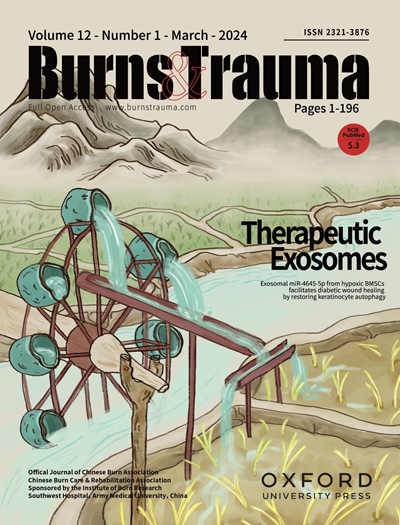氟芬那酸通过ampk - trpml1 -钙调磷酸酶信号通路抑制缺血皮瓣焦亡
IF 9.6
1区 医学
Q1 DERMATOLOGY
引用次数: 0
摘要
背景:缺血性损伤是远端皮瓣坏死的主要原因。先前的研究表明,氟芬那酸(FFA)可以减轻炎症,降低氧化应激(OS),促进血管生成,提示其在保护皮瓣免受缺血性损伤方面的潜在作用。本研究旨在探讨FFA对缺血皮瓣存活的促进作用及其机制。方法采用激光多普勒血流法(LDBF)评价缺血皮瓣的生存能力和存活率。我们通过western blotting (WB)、免疫荧光(IF)、分子对接(MD)、细胞热移测定(CETSA)和表面等离子体共振(SPR)检测了焦亡、OS、转录因子E3 (TFE3)诱导的自噬水平和AMPK-TRPML1-Calcineurin通路的元件。结果FFA能明显提高缺血皮瓣的存活率。与FFA相关的皮瓣存活率的提高可归因于自噬增加,OS减少和焦亡抑制。值得注意的是,促进自噬通量和增强对OS的抵抗力有助于抑制这些皮瓣的焦亡。FFA激活TFE3可促进自噬,减少氧化损伤。当使用腺相关病毒(AAV)-TFE3shRNA降低TFE3水平时,FFA的治疗效果被否定。此外,FFA通过AMPK-TRPML1-Calcineurin途径修饰TFE3活性。结论FFA通过激活AMPK-TRPML1-Calcineurin-TFE3信号通路诱导自噬和抑制氧化应激,促进缺血皮瓣存活。这些发现可能具有治疗意义。本文章由计算机程序翻译,如有差异,请以英文原文为准。
Flufenamic acid inhibits pyroptosis in ischemic flaps via the AMPK-TRPML1-Calcineurin signaling pathway
Background Ischemic injury is a primary cause of distal flap necrosis. Previous studies have shown that Flufenamic acid (FFA) can reduce inflammation, decrease oxidative stress (OS), and promote angiogenesis, suggesting its potential role in protecting flaps from ischemic damage. This study investigated the effects and mechanisms of FFA in enhancing the survival of ischemic flaps. Methods The viability of ischemic flaps was evaluated using laser doppler blood flow (LDBF) and survival rates. We examined levels of pyroptosis, OS, transcription factor E3 (TFE3)-induced autophagy, and elements of the AMPK-TRPML1-Calcineurin pathway through western blotting (WB), immunofluorescence (IF), molecular docking (MD), cellular thermal shift assay (CETSA) and surface plasmon resonance (SPR). Results The findings suggest that FFA significantly enhances the viability of ischemic flaps. The improvement in flap survival associated with FFA can be attributed to increased autophagy, diminished OS, and the suppression of pyroptosis. Notably, the promotion of autophagy flux and an augmented resistance to OS are instrumental in curbing pyroptosis in these flaps. Activation of TFE3 by FFA promoted autophagy and diminished oxidative damage. The therapeutic effects of FFA were negated when TFE3 levels were decreased using adeno-associated virus (AAV)-TFE3shRNA. Additionally, FFA modified TFE3 activity through the AMPK-TRPML1-Calcineurin pathway. Conclusions FFA promotes ischemic flap survival via induction of autophagy and suppression of oxidative stress by activation of the AMPK-TRPML1-Calcineurin-TFE3 signaling pathway. These findings could have therapeutic implications.
求助全文
通过发布文献求助,成功后即可免费获取论文全文。
去求助
来源期刊

Burns & Trauma
医学-皮肤病学
CiteScore
8.40
自引率
9.40%
发文量
186
审稿时长
6 weeks
期刊介绍:
The first open access journal in the field of burns and trauma injury in the Asia-Pacific region, Burns & Trauma publishes the latest developments in basic, clinical and translational research in the field. With a special focus on prevention, clinical treatment and basic research, the journal welcomes submissions in various aspects of biomaterials, tissue engineering, stem cells, critical care, immunobiology, skin transplantation, and the prevention and regeneration of burns and trauma injuries. With an expert Editorial Board and a team of dedicated scientific editors, the journal enjoys a large readership and is supported by Southwest Hospital, which covers authors'' article processing charges.
 求助内容:
求助内容: 应助结果提醒方式:
应助结果提醒方式:


